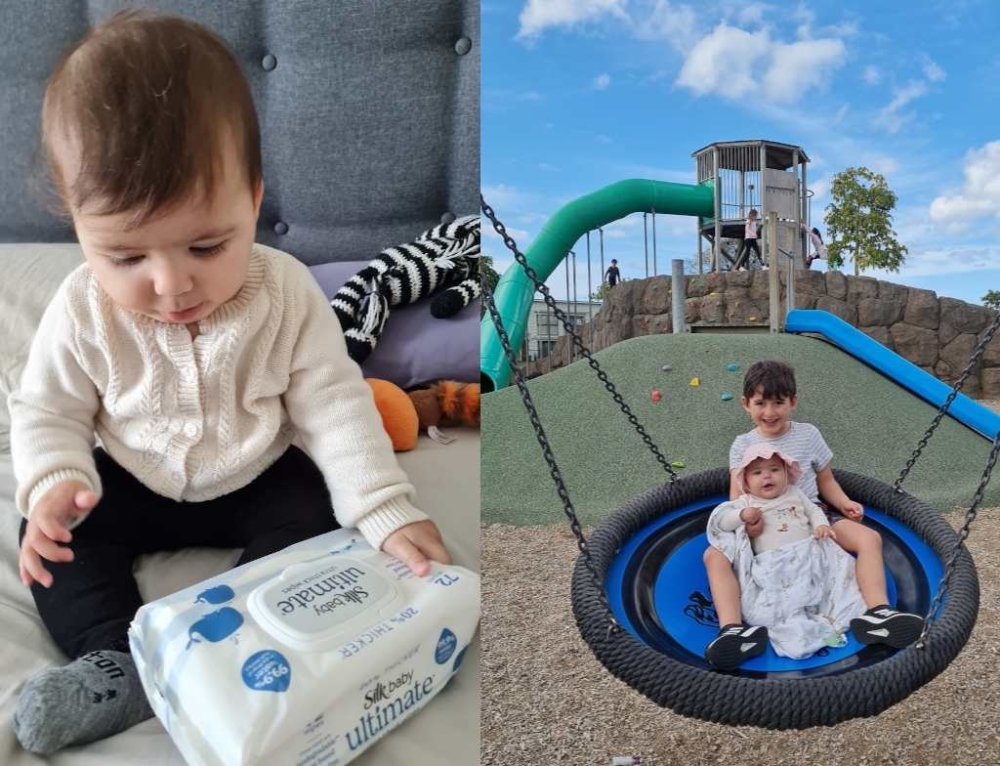Vomiting after birth
In the early days after the birth, many babies will vomit up mucous from their stomach. This is mostly the remnants of the amniotic fluid that was swallowed in the womb, mixed with mucous produced by the lining of the baby’s stomach, in preparation for absorbing milk feeds. Occasionally, the mucous can be quite thick, and the baby may temporarily gag on it in the back of their throat. This can cause them to look like they are choking, and possibly go red, or blue, in the face. Understandably, parents find this quite distressing to watch, however babies will usually tend to deal with it OK, on their own. Sitting your baby upright, or placing them over your shoulder, will generally help them to swallow the mucous (or spit it out).
Vomiting after feeding
Once the baby is taking larger volumes of milk, it is very normal for them to vomit, or ‘regurgitate’, part of their milk around feed time. (However, some babies do not vomit much until they are about 2 to 3 months old.) Your baby may vomit a lot, or only on occasions. (If you are lucky, they won’t at all, unless they are physically unwell). Most babies will tend to vomit ‘off and on’ at various stages during the first 12 months of their life. A few babies will have problems associated with vomiting, due to reflux.
Types of vomiting
Your baby may have little ‘delicate’ vomits that just overflow gently from their mouth, or they may vomit with dramatic style, in a great gush coming from their mouth and nose! (A very attractive party trick!) Observing this type of vomit can leave parents feeling very concerned (and possibly astonished, at the sheer force of it), or upset about all the milk that has ‘gone to waste’. Unlike adults and older children, babies vomit quite effortlessly, and don’t often seem disturbed, or distressed by it.
Common causes of vomiting
The most common cause of a baby vomiting in the early weeks is by some of the milk being brought up with a pocket of air, when the baby burps.
The other term for this type of vomiting is ‘positing’. If milk comes up soon after a feed, it looks (and smells) fairly similar to how it went down – a milky liquid. If the milk comes up a while after the feed, it will usually be partially digested, and often have lumps of curdled milk. Partially digested breast milk doesn’t tend to have a strong odour, but formula milk usually will.
Other reasons for vomiting
The other reason why babies vomit frequently is because the muscle valve at the top of their stomach (between the oesophagus and the stomach) is weak and immature. In adults, this valve closes tightly after swallowing food, to keep food down. It takes a great deal of force to push this valve open to allow an adult to vomit. For babies, the valve does close, but not as tightly. It can be easily forced open with gentle pressure behind it.
In the normal process of digesting milk (and food), and then guiding the stomach contents into the bowel, the stomach performs a ‘contracting’ action. The pressure from these contractions can force milk back up the baby’s oesophagus, to vomit. This may also happen if the baby’s stomach is ‘overfull’, or is gently pressed on. For example, by resting the baby too far over your shoulder, or the baby being quite slouched over while sitting, or if the baby is having ‘tummy time’.
Not to worry
Most babies who vomit frequently are happy, healthy and put on weight. They will eventually ‘grow out’ of it by the time they are one year old (or even earlier for some). It may improve somewhat, after 6 months or so, when your baby is eventually sitting up, and spending more time in upright positions, as gravity will often help to keep things down.
For many parents, it can be hard to keep a smile on your face, if you feel that you are constantly covered in vomit, or it is seeping down the back of your new lounge! Carrying around a spare cloth nappy or hand towel, often becomes part of your wardrobe. (Some parents buy coloured ones, to ‘coordinate’ with their outfits!) You may wish to read more in reflux.
NOTE:
If you are concerned that your baby is vomiting excessively, or seems unwell or distressed, you should seek medical advice. Other symptoms such as the baby having less than six wet nappies in 24 hours, losing interest in feeding or being lethargic, having diarrhoea or a fever, the vomit having a very offensive smell or if it consists of clear, bright yellow, orange or greenish bile fluid, this is of concern, and would require further investigation. If you do not have a local doctor, or they are unavailable, return to hospital that you gave birth in (if it is within the first few weeks after the birth) or go to your nearest children’s hospital (or local hospital).
Blood in vomit
In the first few days after the birth, it is not unusual for a baby to vomit up small amounts of old blood. This is because babies often swallow blood during the birth (whether a vaginal birth or Caesarean). The blood in the vomit usually looks dark red, or brown and ‘coffee ground’ in appearance. This does not harm the baby, and will slowly work its way through their system.
Blood can also be seen in a newborn’s vomit if their mother has cracked and/or bleeding nipples (usually damaged from incorrect positioning of the baby on the breast). Occasionally, the skin of the nipples may not even look obviously split or broken, however there is some soreness associated with the baby suckling. You may wish to read more about sore nipples. The blood in the baby’s vomit may give the milk a pink, or dark red stain, or look like streaks of dark brown. Again, the blood will not harm your baby but you may need to look at correcting your baby’s attachment for breastfeeding, to prevent further nipple damage. Do not stop your baby from breastfeeding, just because they are swallowing blood.
NOTE:
If your baby is being formula fed and you notice blood in their vomit, or if the blood appears in the breast milk continuously and you don’t think you have nipple soreness (or any signs of damaged nipples), you should seek advice from your local doctor.
Tips for coping with your vomiting baby:
- Keep spare nappies, hand towels or washers handy during and after feeds. Carry one around with you when you go out and make use of bibs over gorgeous new outfits, until your baby is ‘on show’ for special occasions.
- Handle your baby gently after feeding. Avoid jiggling them around and lifting them up and down too quickly. (This can have the same effect as the ‘Big Dipper’ ride).
- Many parents worry about replacing what has been brought up. If your baby seems hungry, offer them the breast again, or give them another 40 – 60ml of formula (or whatever amount they are happy to take).
- DO NOT change your babies feeding pattern in an attempt to fix the vomiting. Giving them more feeds, or spacing feeds further apart will not alter a baby’s vomiting.
- DO NOT change your formula, if bottle feeding. This will not prevent your baby from vomiting.
- DO NOT thicken formula (or add other substances such as rice cereal) in the belief that it will be ‘heavier’ and therefore stay down. Altering directions for formula preparation can lead to constipation, unhealthy weight gains and possibly cause vomiting, making the baby unwell. You can read more about the correct preparation of formula in Bottle feeding.
- Remember, the majority of babies who vomit thrive, and are not worried by it. Although their parents may!
This article was written for Kidspot New Zealand.
Find more:
- Get advice on how to feed your reflux baby
- Understand your baby’s reflux
- Learn about hiccups sneezing and other breathing noises







I had a baby who spilled very large amounts without any pain. I had a baby who spilled very little in comparison. Now I have a new nephew who has colic and is in a lot of pain. Babies are so different. I am very lucky that my babies, whether small or large quantities of spilling, didn’t suffer any pain with it. I couldn’t imagine having a wee baby in pain from spilling.
Both of my babies were happy spillers. I spent a lot of time washing my clothes, their clothes and so many towels! They were not losing a lot per feed but it felt like their whole feed. My midwife showed me what 20 ml of water looks like spilt and that put my mind at ease. It really was only about that coming up.
Definitely things to note…vomiting is so common with babies and new parents are always freaking out and not realizing when they should worry or not… tips like these are so handy… safe practices around formula feeding is a must as well ..too common reheating or not mixing well can mean upset tummy for baby too.
Vomitting can get scary but good to know that it’s normal as long as it’s not excessive or blood. 2 key things to note of.
This is very interesting read. My son when he was only a month old for so unsettled so I thought my milk wasn’t filling him enough so gave him a bottle of formula milk. Next minute he was power chucking all over me. I felt so sad coz he was super unsettled that night. I’ll never forget it. The struggles of having a newborn and not knowing what’s wrong really can get you down.
My daughter vomited a bit after feeding, nothing too dramatic luckily although she did have reflux which was not enjoyable I always carried clothes and wipes everywhere I went just in case
I always carried clothes and wipes everywhere I went just in case 